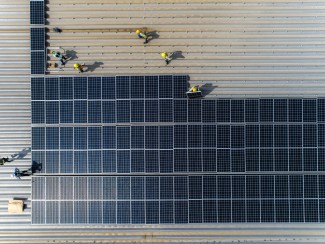Industrial electrification and demand flexibility need to ramp up fast for industry to meet the decarbonization opportunity of renewable power, despite variability challenges. A new report helps put together the pieces through a variety of strategies and technologies.
Transitioning to renewable energy is critical to decarbonizing the industrial sector, but industry is only in the earliest stages of electrifying its activities and preparing for the variability of wind and solar power. A new ACEEE report identifies business practices, technologies, and collaborations that can help make industrial energy consumption more compatible with renewable power.
Wind and solar energy resources are the fastest-growing new sources of energy and are now generally less expensive to build and operate than coal or natural gas. The growth of renewable power is key to helping industrial companies decarbonize quickly and economically, but it will also require them to adapt. While many facilities operate 24/7, they will need to accommodate the effects of weather conditions, the season of the year, and the time of day on wind and solar power generation. Maximizing the use of renewable power in industry is a major undertaking, and we’ve identified tools and strategies that can be implemented in the near term to accelerate the transition.
Recent federal investments can help industrial companies shift away from fossil fuels through electrification
Currently less than 15% of industrial energy consumed is electricity. The most energy-intensive industries, such as iron and steel, cement, bulk chemicals, refining, and food and beverage manufacturing, still use fossil fuels for most process heating (the heat that powers manufacturing). Companies should take advantage of billions of dollars in federal funds, available through grants, loans, and tax credits from the Inflation Reduction Act and other legislation, that aim to incentivize “first movers” in the manufacturing sector and speed the deployment of cutting-edge technologies, that integrate efficiency, electrification, smart manufacturing, storage, and other measures to decarbonize industry.
Existing technologies such as industrial heat pumps can electrify a significant portion of industrial process heat. While recent federal funding can help spur their use, the United States should also look to replicate policies and support structures that have helped enable greater adoption elsewhere, such as the European Union’s widespread district heating networks and other methods of sharing clean energy resources in industrial clusters, or its robust market for heat pumps. Successfully deploying new industrial technologies at scale will require collaboration across stakeholder groups to boost the market signal of successful tools and strategies and build new supply chains.
Demand flexibility can help ensure industrial facilities have reliable power
Wind and solar power are sometimes referred to as “variable renewable energy” because their availability fluctuates. Solar panels can produce power only when the sun is shining, for example. While this variability was initially seen as a barrier to broader deployment of these energy resources, especially for the high, constant demands of some industrial manufacturers, strategies such as energy storage, smart manufacturing, and demand response or flexibility programs can help even large energy consumers adapt. These tools and strategies contribute to an industrial facility’s ability to reduce or shift its demand from one time to another to match the availability of power.
Long-term energy storage is vital to preventing power disruptions. Batteries can be used onsite at utility-scale renewable power installations or behind the meter at the industrial facility. Given the expected high demand for lithium-ion batteries from the transportation sector, industry may benefit from diversifying approaches and considering chemical and especially thermal storage opportunities.
Handling variable supplies of renewable energy is less about turning machines fully on or off, but rather controlling them in intelligent ways. For example, facilities can install and manage variable-speed drives, devices that change the speed of motors by altering the voltage supply. Variable-speed drives can reduce motor energy consumption by approximately 50% in many use cases, creating the capacity for greater flexibility that allows manufacturing facilities to respond to variable power supply.
Utilities will need to implement demand response and demand flexibility programs that incentivize industrial companies to adjust their power consumption responding to energy generation. Dynamic real-time pricing, time-of-use pricing, and critical peak pricing can signal to industrial customers when low-carbon, low-cost energy is available. In addition to cutting demand at times of low availability, large energy consumers can help absorb excess renewable energy, such as at midday, when solar generation is greatest. Most utilities experimenting with these types of pricing programs are in states, cities, and regions that have policies compelling the utilities to reduce their emissions.
New collaborations can support a more complex relationship between industry and the grid
Navigating the changes needed to enable electrification and demand flexibility can be challenging, especially for smaller companies that do not have in-house energy managers or sustainability experts. A wide variety of outside organizations, from technology companies to stakeholders in government, are finding innovative ways to drive progress and support integration between industry and grid-side strategies.
For example, an industrial facility can improve its demand flexibility capacity by implementing thermal storage and adopting manufacturing controls that respond to real-time information, and it can monetize those resources by partnering with a virtual power plant. Virtual power plants, which are just beginning to operate in the United States, aggregate and coordinate distributed energy resources from many homes and businesses to provide grid services. They can work with industrial companies to automate demand flexibility and maximize customer benefits. Virtual power plants have not yet become common in the United States, where they can come into conflict with grid regulatory structures in some locations. Other market and regulatory structures have been more welcoming to this business model, such as in Germany, where virtual power plants and industrial facilities have productively participated in energy markets for years. Utility regulators and policymakers in the United States can enable more virtual power plants to operate here by prioritizing energy demand management over building additional generation and transmission capacity in grid planning processes and by investing in requisite infrastructure, such as smart meters and data communication platforms.
Numerous technologies and stakeholders are available today to help industry take full advantage of renewable power. The main challenge ahead is putting the pieces together and demonstrating how these technologies work to increase market confidence and lower business risk. Renewable power is growing quickly, and industry needs to prepare now to transition to the clean energy future smoothly and economically.


